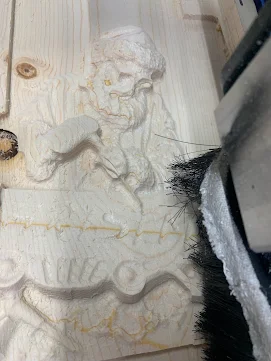Thursday, January 25, 2024
Tuesday, January 2, 2024
The Fine Craft of Selecting the Ideal Endmill Bit for 3D Wood Carving
Wood carving, a time-honored craft, has been catapulted into the modern era with the introduction of computer numerical control (CNC) machines. These technological marvels have elevated the precision, detail, and speed of wood carving to unprecedented heights. However, the linchpin of this intricate process is the selection of the appropriate endmill bit.
A Primer on Endmill Bits
Endmill bits, interchangeably known as router bits, are essential cutting tools employed in milling machines or routers to sculpt materials along their edges. They come in an array of shapes and sizes, each tailored to execute a specific type of cut. When it comes to 3D wood carving, choosing the correct endmill bit is pivotal to attaining the envisioned results.
Crucial Factors in Choosing an Endmill Bit
1. Type of Material
The foremost factor to consider is the type of wood you're dealing with. Hardwoods such as oak or maple demand robust, sharp bits like carbide bits. Conversely, softer woods like pine or cedar can be shaped with high-speed steel (HSS) bits.
2. Design's Shape and Size
The complexity of your design should guide the shape and size of the bit you need. For intricate work, opt for smaller diameter bits with pointed or rounded ends, colloquially known as ball nose bits. For broader, more standard cuts, larger diameter bits with flat ends are preferable. A combination of these, such as using a .25 inch endmill for rough cuts and material clearance before employing a smaller detailed bit like a 3mm tapered ball nose, can save time and reduce wear on the bit.
3. Bit Material
The longevity and performance of the bit are often dictated by its material. Carbide bits, being more durable and maintaining sharpness longer than HSS bits, are ideal for complicated, long-term projects. However, they carry a higher price tag. HSS bits, in contrast, are more affordable and suitable for simpler, shorter tasks.
Most Used Endmill Bits for 3D Wood Carving
1. Straight End Mill Bits
Straight end mill bits excel at creating straight cuts and quickly carving large areas. They are available in a spectrum of diameters to accommodate different project needs.
2. Ball Nose End Mill Bits
Ball nose end mill bits, with their rounded tip, are perfect for 3D contour work. They can sculpt intricate details and yield smooth, curved surfaces.
3. V-Bits
V-bits are utilized for carving fine details and sharp corners. They are available in various angles, typically spanning from 30 to 90 degrees. The smaller the angle, the sharper the point, making it ideal for detailed work.
In Conclusion
Choosing the right endmill bit for 3D wood carving is an exercise in both science and art. It necessitates a deep understanding of your material, the complexity of your design, and the capabilities of your tools. With the right bit, your CNC machine morphs into a potent tool capable of transforming a humble piece of wood into a stunning masterpiece.
Remember, experimentation with different bits will deepen your understanding of their capabilities and assist you in making the best choice for your project. Here's to joyous carving!
Crafting Parts for Bioscience Robotics Team 2375 Regional Champs with Premier Plasma CNC Router!
Experience the intersection of innovation and precision as Premier Plasma CNC Router collaborates with the Bioscience Highschool Robotics ...

-
The Art of Dominating CNC Plasma Tables: 5 Pro Tips to Master Metal Cutting like a Pro! In the world of metal cutting, precision and exper...
-
When it comes to the realm of metal artistry, there exists a powerful tool capable of transforming mere ideas into breathtaking realities: t...

